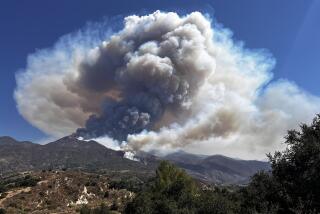A Small Reminder of Pastoral 18th-Century California
- Share via
On the map, the new Arroyo Trabuco addition to O’Neill Regional Park in Orange County looks inspiring. A long green finger shaped like the Mediterranean island of Crete extends from the main part of the park all the way to Mission Viejo. Along the bottom of a tranquil canyon a 5-mile trail beckons.
Alas, as many a great explorer has discovered, the map is not the territory. O’Neill Regional Park is every bit as big and green as it is pictured on the maps; however, the park’s nicest section, Arroyo Trabuco, is almost completely fenced off and closed to public use. Only a small part of the arroyo is open to hikers.
Pending lawsuits against Orange County concerning two mountain lion attacks in nearby Caspers Regional Park prompted the county parks department to restrict use of wild areas, including Arroyo Trabuco. And while lawyers argue and park planners plan, Arroyo Trabuco is being lined with subdivisions.
According to historical accounts, a soldier marching with Gaspar de Portola’s 1769 expedition lost his firearm in this hilly region. He no doubt would be astonished at the number of Orange County place names inspired by his mistake. Trabuco, which means “blunderbuss” in Spanish, names a canyon, a creek, a plain, a trail, a road and even a ranger district of the Cleveland National Forest.
If that unknown soldier hiked this way again, he would be amazed at the drastic changes in the land. But he might recognize part of Trabuco Canyon, where the modern trekker can explore a small slice of the pastoral Southern California of two centuries ago.
A good way to learn about the ecology of Trabuco Canyon is to walk the park’s nature trail. Trabuco Creek Trail, with stops keyed to a pamphlet available at the park’s entry station, meanders through an oak and sycamore woodland and explores Plano Trabuco, or Trabuco Flat, a level alluvial surface deposited by runoff from the Santa Ana Mountains.
Directions to trailhead:: From the San Diego Freeway (Interstate 5) in El Toro, exit on El Toro Road and drive 7 1/2 miles to Live Oak Canyon Road. Turn right and proceed 3 miles to O’Neill Regional Park. There is a $2 vehicle entry fee.
Visitors are asked to sign a Park Use Permit and Waiver of Liability. Anyone under 18 must be supervised by an adult.
Park in the day-use lot near the entrance. Cross the usually dry Trabuco Creek over a cement spillway and pick up the signed trail on the far bank.
The hike: The nature trail explores what botanists call a riparian area, characterized by the lush growth of creek-side vegetation. You’ll walk under oaks and sycamores and be treated to a view of the twin mile-high peaks of Old Saddleback--Mt. Modjeska and Mt. Santiago.
Trabuco Creek, which relies on winter rains for replenishment, is dry this year. During a wet year, Trabuco Creek flows from its headwaters on the shoulders of Old Saddleback about 40 miles through Trabuco Canyon and southern Orange County to its confluence with San Juan Creek, 2 1/2 miles from the Pacific.
At signpost No. 17 of the nature trail, you can leave the loop and continue up creek. The arroyo opens up and you get a good view to the south of Trabuco Flat--a mesa sculpted by the floodwaters of Arroyo Trabuco. On weekdays, the intrusive sounds of bulldozers and construction--from more than 2 miles away--resound through the canyon.
The trail joins a man-made berm on the left side of the arroyo. You can step off the trail to a picnic area near the group camps or continue to the Live Oak Canyon Road bridge. Return the same way.
TRABUCO CREEK TRAIL: 2 miles round trip through O’Neill Regional Park
More to Read
Sign up for Essential California
The most important California stories and recommendations in your inbox every morning.
You may occasionally receive promotional content from the Los Angeles Times.













